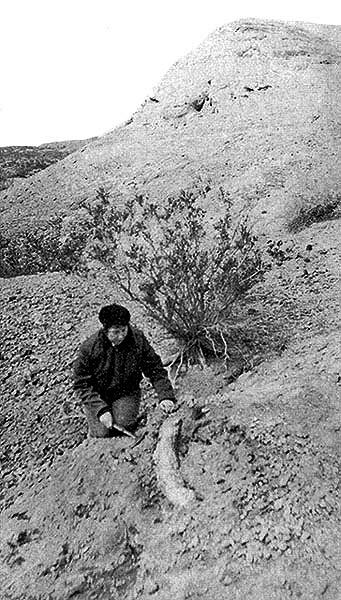|
Part of a mastodon tusk weathering out of the Late Pleistocene
Rogers Lake Beds in Death Valley National Park; image courtesy
the book, Geological Story of Death Valley, by Dr. Thomas
Clements (longtime professor of geology at the University of
Southern California).
This is the very photograph that first fired my fascination with
fossils in Death Valley. During my initial visit to Death Valley
as a youngster, my parents had handed me Dr. Clements' book to
peruse; one of the many photographs in that book was the black
and white image seen above. And it immediately captured my imagination--here
was a 15,000 -year-old mastodon tusk weathering out of ancient
lake beds right there in supremely arid Death Valley! I kept
asking my folks where in Death Valley the fossil might have come
from, but neither they, nor anybody else in our group that weekend
had any real idea.
Then, a number of years later, in April 2003, I was at last able
to pinpoint the general area in Death Valley where those late
Pleistocene Lake Rogers sediments could be found--an extensive
body of water that had actually been a geologic contemporary
of famous Pleistocene Lake Manly, the great freshwater lake that
had stretched 90 miles long by 6 to 11 miles wide, covering most
of the floor of what is now modern-day Death Valley to a maximum
depth of over 600 feet during its highest stand roughly 185 to
160 thousand years ago.
A long, leisurely hike amidst those Pleistocene Lake Rogers sediments
disclosed many fossil bone fragments, plus one readily identifiable
horse astragalus (colloquially
called the ankle bone) that had weathered out on the surface.
This fossil astragalus from a 15,000-year-old horse was one of
the most personally meaningful and exhilarating fossil finds
I have ever made; I had actually been able to find an identifiable
vertebrate fossil from the very locality that had first powered
my interest in fossils in Death Valley. The fossil, of course,
remains just where I found it, way out there in a rugged badlands
region in Death Valley National Park, a foot bone from a horse
that had roamed the shores of a pristine lake roughly 15 thousand
years ago.
|
